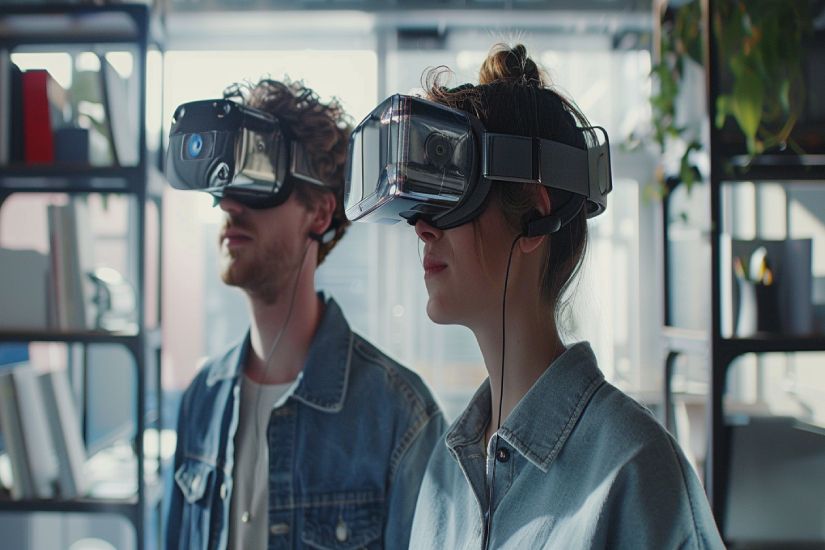Augmented Reality: The New Frontier of Digital Marketing

In digital marketing, innovation is constant. One of the most exciting and promising trends in recent years has been Augmented Reality (AR). This technology, which overlays digital elements on the real world, is transforming the way brands interact with their consumers.
From trying products before you buy them to creating immersive experiences that increase customer engagement, AR is setting new frontiers in digital marketing.
What is Augmented Reality?
Augmented Reality is a technology that combines virtual elements with the user’s physical environment in real time.
Unlike Virtual Reality (VR), which creates a completely digital world, AR enhances the real world with computer-generated images, sounds, and other data.
This technology uses cameras and sensors in mobile devices to add layers of digital information about the physical environment visible through the screen.
AR in digital marketing
Augmented Reality offers a number of advantages that make it a powerful tool for digital marketing:
1. Improved Product Experiences
One of the most common applications of AR in marketing is to allow consumers to visualize products in their environment before purchasing them. Companies like IKEA and Sephora have implemented AR apps that allow users to see what furniture would look like in their home or try out different shades of makeup on their face.
This “try before you buy” ability reduces return rates and increases customer satisfaction.
2. Interactive Ad Campaigns
Traditional advertising campaigns are evolving with the addition of AR. Brands can create interactive ads that users can browse from their mobile devices.
For example, Pepsi Max launched a campaign where users could interact with an AR ad at a bus stop, seeing how fantastical creatures appeared to appear in the real world.
These types of campaigns not only attract attention, but are also highly shareable on social media, amplifying their reach.
3. Increased Customer Engagement
AR allows brands to create immersive experiences that capture the user’s attention and encourage more interaction. These experiences can range from promotional games to virtual product tours.
For example, the LEGO toy brand has used AR in its stores to allow kids to see what finished building sets will look like, increasing interest and likelihood of purchase.
4. Improved Data & Analytics
Another advantage of AR in digital marketing is the ability to collect detailed data on how consumers interact with products and campaigns. AR analytics can provide valuable insights into user behavior, allowing brands to adjust their marketing strategies to be more effective.
This information can include data on how long users interact with an AR experience, which features are the most popular, and what the dropout points are.
Success stories in the use of AR
1. Pokemon GO
Pokemon GO is one of the most well-known examples of AR that has had a significant impact on digital marketing. The game combines elements of AR with a geolocation system, allowing users to capture Pokemon in the real world.
This global success demonstrated the potential of AR to create highly engaging and viral user experiences.
2. IKEA Place
The IKEA Place app allows users to see what furniture would look like in their home using AR.
This tool has significantly improved the shopping experience by providing a convenient way to visualize products in a real-world environment, leading to an increase in sales and a reduction in returns.
3. L’Oréal
L’Oréal has embraced AR to allow customers to try on makeup virtually through its app.
Not only does this technology improve the shopping experience, but it also provides valuable data on consumer preferences, helping the brand personalize its offerings.
Challenges and future of AR in digital marketing
Despite its numerous advantages, AR in digital marketing also faces some challenges. Implementing AR experiences can be costly and requires advanced technology and specialized skills. Additionally, it’s crucial that AR experiences are intuitive and easy to use to avoid frustrating users.
However, the future of AR in digital marketing is promising. As technology continues to evolve and become more accessible, we are likely to see an increase in adoption.
Brands investing in AR will now be well-positioned to take advantage of this emerging trend and deliver innovative and engaging user experiences.
Augmented Reality is redefining the digital marketing landscape, offering new ways to engage with consumers and enhance their shopping experiences.
As this technology continues to advance, its impact on digital marketing will only grow, setting new frontiers and possibilities for interaction between brands and consumers.